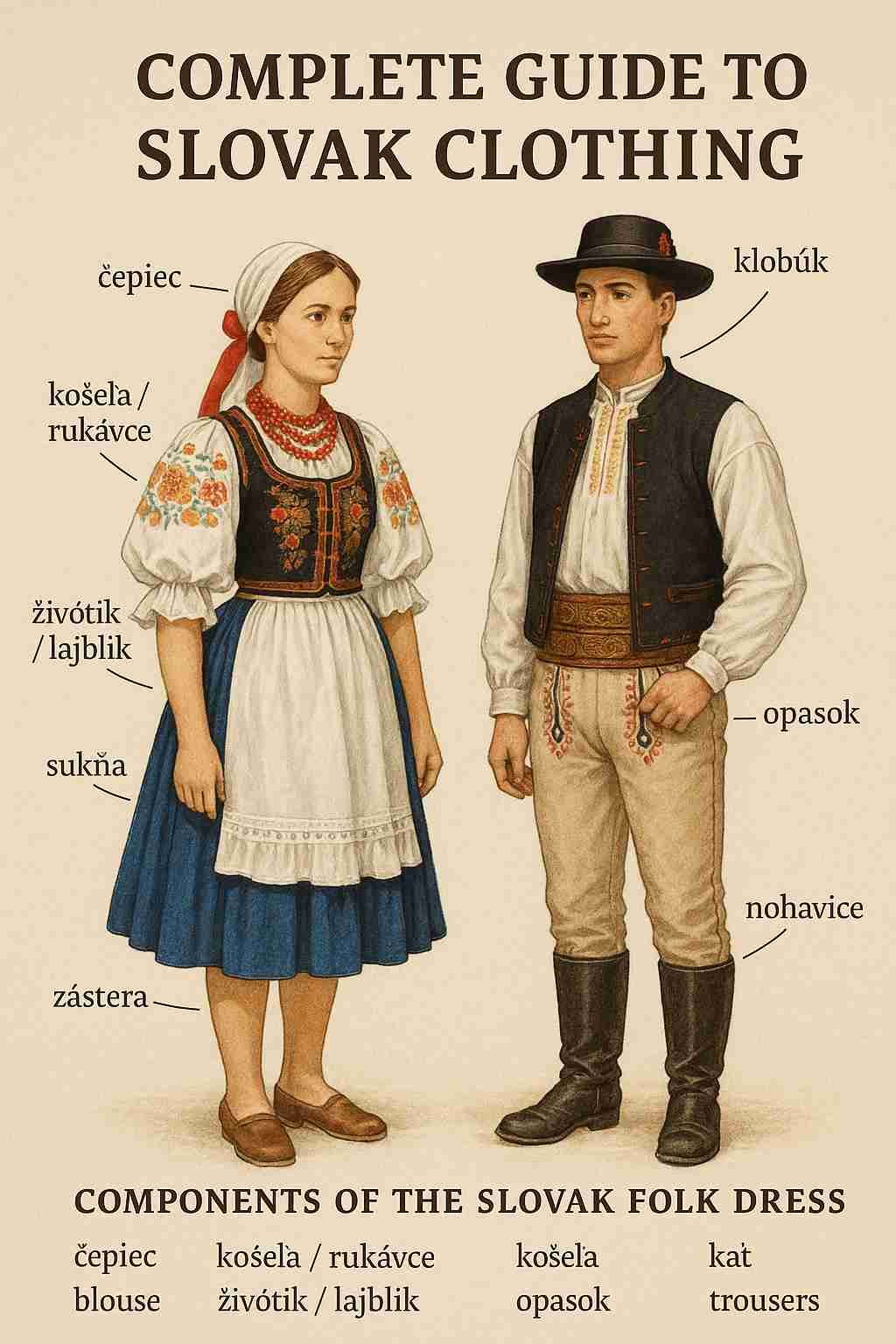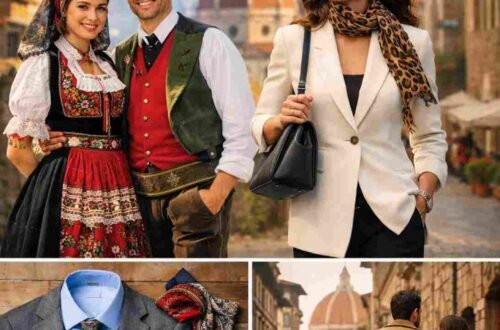Tradional Slovak clothing, called the kroj, is an important part of Slovakia’s history and culture. Each region of the country has its own style, colors, and embroidery. Long ago, people wore these clothes every day. Today, they are mostly worn at weddings, folk festivals, and national holidays.
This guide explains what the kroj is, how it looks, how it was made, and how it is used today.
1. A Short History of Slovak Clothing
Slovak folk clothing has changed over time. It tells the story of how people lived, worked, and celebrated.
-
Before 1800: People made their own clothes from linen, wool, and hemp.
-
1800–1900: Factory fabrics appeared, but people kept their traditional clothes for Sunday or special events.
-
1900–1950: The kroj became a symbol of Slovak national pride.
-
After 1950: People started wearing modern clothes but used kroj for holidays and festivals.
-
Today: Artists and designers are bringing the kroj back in modern styles.
Quick Timeline
| Time Period | How People Used Kroj | Notes |
|---|---|---|
| Before 1800 | Everyday wear | Handmade from local materials |
| 1800–1900 | Symbol of region | More colors and decoration |
| 1900–1950 | National symbol | Used at celebrations |
| 1950–2000 | Festival wear | Preserved in folk groups |
| 2000–Today | Fashion and heritage | Folk-inspired designs appear again |
2. What Does “Kroj” Mean?
The word kroj means “cut” or “style” in Slovak. It describes how a traditional costume is made and worn.
Each region has its own kroj. Even villages close to each other can have small differences.
Read also: Stilyagi
Common Slovak Words Used for Clothing
| Slovak Word | English Meaning | Who Wears It |
|---|---|---|
| Košeľa | Shirt or blouse | Men and women |
| Lajblík / Živôtik | Vest or bodice | Women |
| Sukňa | Skirt | Women |
| Zástera | Apron | Women |
| Čepiec | Headdress or cap | Married women |
| Nohavice | Trousers | Men |
| Opasok | Leather belt | Men |
| Klobúk | Hat | Men |
| Rukávce | Embroidered sleeves | Women |
3. Parts of the Slovak Folk Dress
A. Women’s Kroj
Women’s costumes are colorful, layered, and full of detail.
Main Parts:
-
Blouse (košeľa or rukávce) – White, made from linen or cotton, often with embroidery on the sleeves.
-
Vest (živôtik or lajblík) – Tight around the waist, decorated with lace, sequins, or beads.
-
Skirt (sukňa) – Full and pleated, made from bright fabric.
-
Apron (zástera) – Worn over the skirt, decorated with embroidery or ribbons.
-
Headdress (čepiec) – Married women wear caps; single girls wear ribbons or flower wreaths.
-
Accessories – Beaded necklaces, scarves, shawls, and leather shoes or boots.
Color Meanings (commonly used):
| Color | Meaning |
|---|---|
| Red | Love and strength |
| Blue | Faith and calmness |
| White | Purity |
| Green | Nature and hope |
| Gold | Wealth and festivity |
B. Men’s Kroj
Men’s folk clothes are simpler but strong and carefully made.
Main Parts:
-
Shirt (košeľa) – Made from linen or hemp, often with small embroidery.
-
Trousers (nohavice) – Made of wool or linen; some regions use decorated leather trousers.
-
Vest or jacket – Wool or sheepskin with colorful stitching.
-
Belt (opasok) – Wide leather belt with carved patterns.
-
Hat (klobúk) – Black felt or straw, decorated with ribbons or feathers.
-
Boots (krpce) – Traditional handmade leather shoes.
4. Materials and How They Were Made
In the past, people made almost everything by hand using what they had in nature.
Common Materials:
-
Linen and hemp – Light and cool, used for shirts and blouses.
-
Wool – Warm, used for jackets and skirts.
-
Cotton – Used later for festive clothing.
-
Leather – For belts, vests, and shoes.
-
Silk and ribbons – For decoration.
Traditional Techniques:
-
Weaving – Making cloth on a loom.
-
Embroidery – Adding colorful designs with thread.
-
Modrotlač – Blue-and-white cloth made using a special dye method (now UNESCO-protected).
-
Lace-making – Used for aprons, collars, and cuffs.
Read also: Complete Guide to Korean Clothing
5. Regional Differences
Even though Slovakia is small, the kroj looks very different from one region to another.
| Region | What Makes It Special |
|---|---|
| Myjava (West) | White embroidery on white cloth; simple and clean look. |
| Podpoľanie (Central) | Bright colors and rich sleeve embroidery. |
| Liptov (North) | Floral designs and colorful ribbons. |
| Spiš / Šariš (East) | Gold thread and lace; elegant and detailed. |
| Zemplín (South-East) | Darker colors and layered aprons. |
These local designs help people recognize where someone comes from, just by their clothing.
6. When People Wear Kroj Today
Today, Slovaks wear kroj on special days rather than every day.
Popular Occasions:
-
Folk festivals – like Detva and Východná, where villages show their regional clothing.
-
Religious holidays – Easter, Christmas, harvest festivals (Dožinky).
-
Weddings and family events – Brides often wear parts of a kroj, such as the apron or headdress.
-
Folk dance shows – Groups like Ľúčnica and SĽUK perform in traditional costumes.
-
National holidays – Parades and celebrations.
You can also see kroj in museums, markets, and Slovak communities around the world.
7. How to Wear and Take Care of Kroj
Wearing kroj is not only about fashion—it’s about respect for culture.
Tips for Wearing It:
-
Learn the region – Each design has its own story and rules.
-
Use natural fabrics – Linen and wool are best.
-
Buy from artisans – Support local people who keep old skills alive.
-
Don’t mix regions carelessly – Unless it’s a modern design, keep patterns true to one area.
Care Tips:
-
Hand wash gently in cool water.
-
Keep out of sunlight to protect colors.
-
Store flat or wrap in clean cotton fabric.
-
Use acid-free paper if storing for a long time.
8. Modern Fashion Inspired by Kroj
Many Slovak designers use folk patterns and embroidery in new ways. They mix the past with the present.
Examples of Designers and Brands:
| Designer / Brand | What They Create |
|---|---|
| Folklore Fashion | Dresses and blouses with old-style embroidery |
| Zuzana Haková | Bridal designs with folk lace |
| Lujza Marko | Modern streetwear with regional colors |
| Lucia Ferenčuhová | Uses old modrotlač (blueprint) methods |
| Parta Studio | Folk-inspired jewelry and accessories |
Why It Matters:
-
Keeps old crafts alive.
-
Encourages slow, eco-friendly fashion.
-
Connects young people with their culture.
-
Creates new jobs for artisans.
9. Where to See Slovak Clothing
If you travel to Slovakia, you can see or even try kroj in many places.
Museums and Centers
| Place | What You Can See |
|---|---|
| Slovak National Museum – Martin | Kroje from all regions |
| ÚĽUV (Folk Art Center) | Workshops for embroidery and blueprint dyeing |
| Museum of Folk Culture – Banská Bystrica | Displays and local crafts |
| Košice Folk Market | Handmade clothes and souvenirs |
Folk Events
-
Detva Festival – Music, dancing, and regional kroj shows.
-
Východná Festival – The largest folk event in Slovakia.
-
Myjava Cultural Days – Costume competitions and traditional food.
Abroad, Slovak communities in Canada, the USA, and Australia also wear kroj at cultural events.
10. The Spirit of Slovak Clothing
The Slovak kroj is more than fabric and thread—it is a story of family, work, and beauty. Every flower stitched on a blouse, every pleat in a skirt, shows the care and creativity of the people who made it.
Today, wearing a kroj connects Slovaks with their roots. Designers, museums, and festivals help make sure this tradition never disappears. The kroj shows that culture can grow and change while still keeping its heart.
Conclusion
Slovak traditional clothing is a proud symbol of the nation’s past and present. It tells who the Slovak people are—hard-working, creative, and deeply connected to their land.
From old village looms to modern fashion runways, the kroj continues to shine as a beautiful piece of living history. When people wear it, they carry the spirit of their ancestors and the artistry of their homeland into the modern world.





